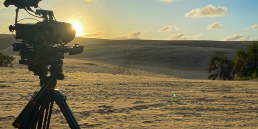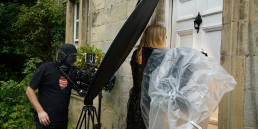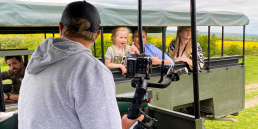Stock footage. A term we are all familiar with. But are these pre-shot clips really worth the mantle they seem to occupy in peoples minds?
Now don’t get me wrong, we use stock, and it has come to the rescue more than once. But we have also had experiences where it has become the bane of everyone’s lives.
This post is here to help clarify how it can be used to it full potential. Helping you elevate, not limit, production value.
How NOT to use stock
The constant battle when editing with stock is continuity. Where most stock sites show you similar clips or footage form the same shoot, it’s very unlikely that those other clips tell your story. This results in using clips shot on any number of combinations of camera and lenses and expecting them to sit together, never mind convey the subtleties needed to effectively showcase a product or brand personality.
It’s simply never going to cut as well as something shot to spec.
For this brand piece we produced for Fairy, with a tight turn around and limited budget, the client decided stock would be the way to go.
Unfortunately once the first cut was done the glaring hole became apparent – where is the product? So to remedy this we ended up shooting spec shots of the product anyway and then shoehorning them into the cut. Where we have the ability to create a good edit I cant help but think this could have been a much more succinct and on brand piece if we had just shot it from the start.
The misconception of stock
Every time I have had a stock film brief the rationale has been down to one of 3 preconceptions:
- “We cant afford to shoot something bespoke”
- “We don’t have time”
- “It’s not feasible.”
Now all of these can be valid reasons to use stock, but not as a solution in its entirety. Plus they are not necessarily true.
1. To this day I have no idea where the misconception that stock footage is a cheep way to produce an entire film came from. At an average of $120 a clip for acceptable quality footage, a painfully slow 4k edit (at one clip a second) is going to cost you $7,200 per minute. Thats not cheep.
2. Time is relative. Unless you already know what exact clips you want to use your production company is likely going to spend a similar amount of time going backwards and forwards looking for and licensing the clips as it would to just shoot them to spec. Every stock edit I have ever worked on has taken far more rounds of amends than a properly planned and shot piece.
3. In this digital age the world is smaller than ever before, and with a good crew and well planned concept you will get a far better result from a remote shooting crew than you will making an entirely stock production. We do this all the time. In one week we shot this piece for Tomra with remote crews in Australia, Japan, Norway, Belgium and the UK. Then had all the footage in the studio ready to edit by the following monday. All from what began as a stock film brief and budget.
How to use stock
Now saying that there very much is a place for stock in modern productions. However, the way stock is used needs a rethink. Stock shouldn’t be $20 clips haphazardly cut together to create a Frankenstein’s monster of a sequence, it should be used as premium content to enhance productions. When used like this it can be a great asset to any production, saving time, money and a lot of effort.
Anticipating where stock is appropriate in a production is key in making it not feel like stock. Approve the clips before the shoot so the crew can storyboard around them. That way the surrounding clips can be shot to match the necessary stock as best as possible. Take a look at how this works in our brand advert for Avani Hotels.
The rules
In my experience there are 5 prime examples that guide the effective use of stock footage.
1. Last minute additions
We have all been there, a signed off board and shot list and then the first cut comes back and its just not quite there. Something is missing, or a new steak holder ‘offers’ their opinion far to late. Whether it be a reaction, a detail or an extra touchpoint that was previously overlooked a single stock cutaway can be a great way to address this.
2. Saving your ass
Now we’s all like to think that this shouldn’t be here, but file corruptions, lost cards and accidental deletions unfortunately do happen. If there is no other choice but to re-shoot (or pull the plug entirely), just see if a stock clip or two can bridge the gap in the sequence.
3. Feasibility
Without doubt this is the most common time we use stock footage.
Sometimes it’s simply not feasible to get the shot that will make all the difference. Whether it be aerial footage in a no-fly zone or a logistical impossibility to get to the filming location. Stock footage exists for exactly these scenarios. Hollywood does this all the time, one or two wide stock shots cut with bespoke content shot so it feels like it lives together.
4. Cost V Budget
Sometimes it’s that one shot that we all know will just make the film. However, where it could easily be within a crews remit to capture, it doesn’t always add up financially.
Whether it be an underwater moment or a sighting of a rare animal. These shots can require hours of prep and filming time and specialist equipment. But before you right it off, could a stock clip achieve this?
5. Combating change
Locations are in a constant state of maintenance. Sods law it will be the day before you’re scheduled to film that key landmark will be scheduled to be wrapped up in scaffolding. Instead of delaying or rushing production, could a cleverly scripted stock shot help you shoot around it?
When you alter your mindset from trying to build sequences (or even entire videos) out of stock to using it to enhance your productions, it opens up a whole new world of possibilities and can even increase production value.
Case Study
One of our best examples of using stock footage is our Festival of Chinese flavours production for Shangri-La. Find out how we turned a stock film brief, on a tight timeline, into this award winning campaign.

Ross Dixon
Creative Director
Related Posts
August 12, 2023
5 Proven Strategies to Maximise Your Video Advertising Results
With the advent of social media, and…
July 8, 2023
The Complete Guide to Hiring a Video Production Company in Newcastle
With the advent of social media, and…
June 4, 2023
8 things you should know before filming with animals
With the advent of social media, and…


